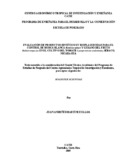Evaluation of chemical and bio-pesticides for the control sweetpotato whitefly Bemisia tabaci and tomato fruitworm Helicoverpa zea in tomato Lycopersicon sculentum production in Sébaco, Nicaragua
Alternative title
Evaluación de productos sintéticos y bioplaguicidas para el control de mosca blanca Bemisia tabaci y gusano del fruto Helicoverpa zea en el cultivo del tomate Lycopersicon sculentum, Sébaco, Nicaragua
Description
Tesis (Mag. Sc) -- CATIE, Turrialba (Costa Rica), 2005
Abstract
El objetivo principal fue evaluar el efecto bioplaguicidas de nim aciete 0.15 EC y spintor comparado con plaguicidas sintéticos, confidor y metamidofos para el control de mosca blanca Bemisia tabaci en etapa vegetativa y gusano del fruto Helicoverpa zea en etapa reproductiva del cultivo de tomate (Lycopersicom esculentum). Como resulado se obtuvo que la mayor eficiencia en el control sobre poblaciones de huevos, ninfas y adultos de Bemisia tabaci, se presentó en los tratamientos sintéticos, confidor*metamidofos umbral económico y calendarizado, seguido de los tratamientos bioplaguicidas, nim*spintor umbral económico y calendarizado, siendo el testigo (cero aplicación), reflejando mayor indidencia de huevos, ninfas y adultos de Bemisia tabaci. También se estudio el efecto de los productos evaluados sobre poblaciones de enemigos naturales de Bemisia tabaci y Liriomyza spp, presentando mayor incidencia de insectos benéficos los bioplaguicidas y el testigo absoluto, se realizó un análisis económico, donde se consideró: presupuesto parcial y tasa de retorno marginal (trm), obteniendo la mayor tasa de retorno los insecticidas sintéticos, los cuales alcanzaron los rendimientos más altos . The primary objectives was to evaluate the effect of two biological pesticides (0.15 EC Neem Oil and Spinosad) and of two chemical pesticides (Confidor and Metamidofos) on whitefly (Bemisia tabaci) in the vegetative stage of tomato, and on fruitworm (Helicoverpa zea) during the reproductive stage of tomato (Lycopersicon sculentum). The best control of whitefly eggs, nymphs and adults was obtained in the chemical pesticide treatment with confidor*metamidofos applied at threshold followed by the scheduled applicatio and by the biopesticide treatment neem*spintor. The greatest incidence of eggs,nymphs and adult whitefly was observed in control treaments (no pesticide aplication). The effect of the pesticides on natural enemies of B. tabaci and Liriomyra spp. was also studied, with the greatest incidence of natural enemies occuring in the treatment with bio-pesticides, followed by the control treatment. An economic analysis was done considering production costs and marginal rates of return. the best rate of return was obtained using chemical pesticides, which provided greatest yields.
Keywords
Asesor
Carballo V, M
Publisher
CATIE, Turrialba (Costa Rica)
Is part of
Magister Scientiae en Agricultura Ecológica
URI (Permanet link to cite or share this item)
https://repositorio.catie.ac.cr/handle/11554/5093http://orton.catie.ac.cr/repdoc/A0536e/A0536e.pdf
Collections
- Tesis [3111]


